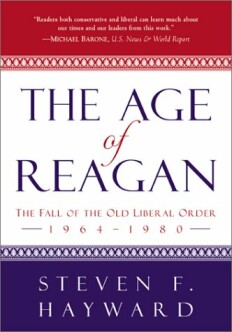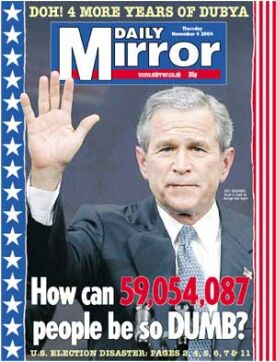Home Truths
The Times Literary Supplement
THE AGE OF REAGAN
THE FALL OF THE OLD LIBERAL ORDER
1964-1980
by Steven F. Hayward
Roseville, California: Forum/Prima, 812 pp., $35
“Revisionist historians two or three generations from now”, writes Steven Hayward, “are likely to begin making out the argument that the United States won the ultimate victory in the Vietnam War, and that it should be seen as the turning point of the Cold War”. Hayward thus modestly places himself in the vanguard of the future, as his book, a veritable abattoir for sacred historiographical cows, is intended to make just this argument — and a great many others of almost as radical a tendency. And if we are left with American victory in Vietnam not quite established, there are a great many other striking and persuasive insights, at least into what may be the most transformative dozen years in American history, from 1964 to 1976. The final four years of his survey are less interesting. The failures and the abjectness of American foreign and domestic policy in the Ford-Carter years are but too well understood and not, like those of the Johnson-Nixon period, subject to a like reinterpretation.
Part of his purpose, for instance is to take issue with what he calls the “Standard Heroic Account” of the Watergate burglary and cover-up and the subsequent resignation of President Nixon. Although he briefly flirts with the crackpot theory of Watergate as the Silent Coup portrayed in Len Colodny and Robert Gettlin’s book of that title in 1991, the seriousness and importance of his treatment of this subject lies in his placing it in the context of the left’s hatred of Nixon, together with the intemperance of political language born of the liberal campaign against Barry Goldwater (who was almost routinely called a fascist and compared to Hitler) in 1964, as well as the larger struggle between Nixon and the Democratic Congress over the immense and growing inertial power of centralizing forces in Congress and the Federal bureaucracy. “By declaring his intent to control, and reduce in size, the structure that maintained the power of the Democratic Party, Nixon would be launching one of the most bitter political fights in American history”.
After his landslide re-election in 1972, an election in which he had made his presidency the focus and scarcely even bothered to campaign for his fellow Republicans in Congress — where, accordingly, the Democrats remained in the majority — Nixon’s “asserting his station above Congress as a barometer of the popular will” was a considerable provocation. And it was followed with attempts at administrative reform that had not been congressionally authorized and “impoundment” of congressionally- appropriated funds for federal programs Nixon did not approve of. The subsequent eagerness of the congressional investigators into the Watergate break-in was not coincidental. Hayward ominously notes that Senator Sam Ervin, Nixon’s chief senatorial inquisitor during the Watergate hearings of 1973, had called the new budgetary proposals “executive usurpation of legislative power” well before those hearings got underway. “Therein lies,” writes Hayward, pushing a bit too far, “the thread that unraveled Nixon’s fortunes”.
He also notes that, after the Kennedy-Johnson years there was “an undercurrent that Nixon’s election was a fluke, that his administration was somehow illegitimate, because, after all, the Democrats are the natural ruling party”. Although he does not say so, there was something similar in the right’s hatred for Bill Clinton in the 1990s, after Reagan-Bush had got them used to thinking of themselves as “the natural ruling party”. In both cases too, the irony was that the hated man was in some respects more of the hating party than of his own. Clinton pushed through the NAFTA arrangement with Mexico and Canada that had been negotiated by his predecessor and at least acquiesced in welfare reform and other Republican measures. Nixon imposed wage and price controls, was an early environmentalist — when much of the left regarded environmentalism as a conservative ploy to detract attention from the war and urban poverty — and introduced Americans to “affirmative action” and other leftist nostrums. As Senator Moynihan, who had served in the Nixon administration, later said, “We may well have been the most progressive administration on domestic issues that has ever been formed.”
Hayward’s own sympathies are perhaps rather too much on show when he writes that, after Nixon’s victory in 1972, “What followed was two years of oscillating bombshells (can bombshells oscillate?), irony, and a lynch mob mentality among the perennial Nixon-haters,” but it is hard not to agree with him when he goes on to quote, like Joan Hoff (in Nixon Reconsidered) before him, Norman Mailer’s remark at the time that “we won’t be happy until we cut Richard Nixon’s heart out and hold it high on the summit of the Presidential pyramid while an ooh goes up from the crowd”.
But Watergate is only a part of it. In a larger sense his book is an argument with the Standard Heroic Account of the last 40 years. As such it is another shot in the battle over the historiography of the 1960s, which is what really lies behind the so-called “culture wars” of America today. Most academic historians and the media consensus, still dominated by now-aged reporters who were getting their start in the 1960s, hold to the view that the decade was a period of heroic liberations — most notably from colonialism, from racial segregation, from traditional sexual restraints and traditional male dominance or “patriarchy” — and that its twin achievements in America were the civil rights and the anti-Vietnam War movements. Hayward concentrates his fire on these two triumphs of the American left and purports to show how the first’s wrong turning after the landmark civil rights legislation of 1964 produced today’s racial “balkanization” while the second was fundamentally misconceived from the start — though not without the help of the inept and foolish Johnson administration — and gradually grew dishonest as well.
Not surprisingly, the media come in for rather a lot of bashing, not only in connection with Watergate, which is supposed to have been their finest hour, but also for the reporting, or mis-reporting, of the Goldwater candidacy in 1964, the Reagan phenomenon in the 1960s and again in the 1970s, the Tet offensive and the New Hampshire primary of 1968, which between them reversed the tide of public opinion on Vietnam (though both arguably because of misperceptions of what had actually happened), and the Nixon presidency as a whole. Hayward notes one after another the important facts that the Standard Heroic Account leaves out with respect not only to American successes in Vietnam and the real nature of Nixon’s failure but a host of other markers along the way from 1964 to 1980 — for example, the McGovern commission’s changes in the rules of the Democratic party nominating process after the fiasco of Chicago in 1968. These were “intended to ‘open up’ the Democratic Party, but in fact the effect of the rules changes adopted in the aftermath of Chicago was to lose the party to many of its traditional core constituencies and capture it for a new set of mostly left-leaning factions”.
Hayward also points to the immensely important but too-little recognized fact that “Like the War on Poverty, the Vietnam War originated and grew amidst the attitude that American wealth, power, and expertise could engage in successful social engineering and ‘behavior modification’. The Vietnamese Communists were not unlike America’s poor in their minds: Apply the right carrots and sticks, and they’ll swing around to what we want them to do. This attitude would turn out to be the most difficult and painful lesson in hubris in American history”. One consequence of the same “attitude” was that “traditional ideas of warfare and victory. . .were regarded as obsolete” and were replaced by something called “flexible response” which seemed to have been vindicated during the Cuban missile crisis.
One would have liked for him to have spent a bit more time on so centrally important a datum — on how far, for instance, this attitude grew out of America’s love-affair with psychiatry and psychological testing in the 1950s. Such subjects are perhaps outside the scope of a book that focuses its attention on the years between 1964 and 1980, but it is odd that he devotes only a couple of pages, in the context of a general discussion of hippiedom, to the sexual revolution, which was arguably the most important and far-reaching of all the “liberation” movements of the 1960s, and hardly without its effects on the others. As in other instances, Hayward tries to minimize the newness of what the allegedly revolutionary decade brought (“That the ‘old taboos’ were dying out was a commonplace theme in the media and among social commentators since at least the late 1950s”), but some things really were different.
There are rather a lot of typographical mistakes and some plain bad editing — or bad writing: “forebearers” for forebears; “loathe” instead of “loath” in “to be loath to do”; “x is attributed with the remark” for “the remark is attributed to x”; or “Like poverty, liberals talked of treating the ‘root causes’ of crime. . .” Sometimes, as well, the stridency of Hayward’s polemical purpose can get in the way of its larger, more persuasive argument about the misdirection of recent American historiography. He writes, for example, that “the idea of the limits to growth has remained a core concept of environmentalism. . .and became the new visage of liberal guilt. For some varieties of the liberal mind, gloom is exhilarating, and the limits to growth offered a large-scale sequel to the Vietnam War”.
Of course, what he must mean is that liberal opposition to unrestrained growth was in some ways similar to liberal opposition to the Vietnam War, a defensible if not quite self-evident view and one probably shared by many liberals. But this is not what he says, and he leaves the points of similarity to be implied in his vague psychologizing about “guilt” and “gloom”. Similarly, he writes that “the allure of Black Power also proved irresistible to many liberals who liked nothing more than to have their liberal guilt confirmed in the most fulsome way.” This may be true, but it does not help his case that he states it as fact and without further confirmation.
But for all its faults, Hayward’s book has one great virtue, which he sums up in a quotation from Lord Charnwood’s biography of Lincoln: “Nor should the writer shrink too timidly from the display of a partisanship which, on one side or the other, it would be insensate not to feel. The true obligation of impartiality is that he should conceal no fact which, in his own mind, tells against his views.” This is well said and scrupulously adhered to, so far as I can tell, and the result is, at least for its first three quarters, a book that reads at times like a grand historical drama, a kind of War and Peace of the American century, complete with romance and adventure and tragic characters, a thrilling survey of what we might have thought to be familiar history but which appears here quite transformed.
Discover more from James Bowman
Subscribe to get the latest posts to your email.







